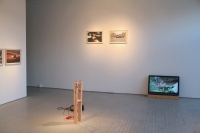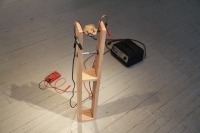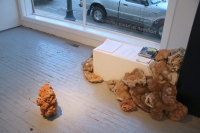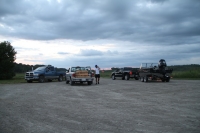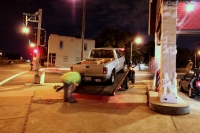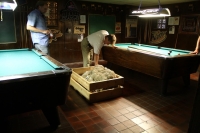Sisyphus Americana (.n)
An exhibition by Andreas Kindler von Knobloch + Carl Giffney
Hoffman LaChance
St Louis, MO, U.S.A.
16 - 31 August 2013
Presented by Paul ArtSpace

_
What a heavy burden God has laid on mankind! I have seen all the things that are done under the sun; all of them are meaningless, a chasing after the wind.
Ecclesiastes
Quartz is piezoelectric, which means that it creates a voltage when deformed. The higher the altitude, the less likely a lighter with piezo-electric ignition is to work.
Wikipedia
Ford divides the day. He allots 8 hours for work, 8 for consumption and 8 to rest for the next days’ work and consumption. He sets the cycle, regulates the days of the American worker. He is an idealist. He believes in a better society. Brilliant men fail. It happens all the time. There are no masters of change.
If you are unfamiliar with Sisyphus, he was a wise man on earth. He was also a journeyman. He was cursed for loving the earth too much. He defied the gods and was exiled to an older, even more contingent and unforgiving world. It was his fate to roll an impossible stone up mountains. Well, it was one mountain, but the rock never stayed put, so the numbers grew. The stone always returned to the bottom of the mountain—always back to that unholy plain.
Piezoelectric ignition is used in common lighters. It is also the element used to power most quartz based wristwatches. The small stone ignites. It also perpetuates. The process was discovered in 1880. Just in time for the new century.
A common tension with fordist/ postfordist economies are conflicts between market demands and the means of production- that’s what the theory says. But even the theories don’t give much credit to the men at the bottom of the market (hegemony). I mean, workerism? The laborer is a hero, they say. He is a faceless hero, even to his champions. He is a martyr working in isolation. He is an ideal, almost never a man, really. I’m generalizing. How do you make sense of particulars in these terms?
Sisyphus seems damned. He seems cursed. We are left to imagine the wisest of men, a great lover, pressed against a stone, defying a constant pull backward and down. His hands are wasted, muddy and raw. His back is wasted too. He presses up. There is a moment of failure. The rock can’t climb. It hangs suspended in a instant when all invested hope is diffused. Because it won’t rise, it won’t stay. We only coast in one direction, right? So it falls, retracing the path of its incremental ascent, but faster. This is S. seeing his curse released and falling. What are his thoughts during its descent? What are his thoughts as he follows it down?
How do you construct a vision of American ethos? How do you create a concise vision of such an unruly experiment-- one that seems so ecstatic and terrifying? Can you see its promise? Do you recognize all of its innovation as facile groping in the dark? Can you understand its means to forming up substantial futures? How do you make sense of the values of a courageous and lost child? How can you not be enamored with the brilliant and eccentric residue of its pursuits? We hang its textures on our walls and transmit them through the air. We project them on screens. We drive them around. We feel excited and mobilized by it all. We also get a little soft about what we feel, and recognize this in certain moments. We question ourselves for such flimsy indulgence. We’re torn by this place. We celebrate it full stop, and we hope for better.
On the unholy plane S. faces the stone again. In this moment he knows who he is. He knows where he’s been and recognizes all the virtues of life on earth. His wisdom is sealed by death. S. will roll the stone and make it rise. He will perpetuate an awe inspiring and meaningless task, but he will do so with all the knowledge that casts gods and heroes aside. His recognition is seated in a moment. Right here, right now he is a locus-- he is the vector and he its realization. He sets the stone and he makes it rise.
essay by Michael Woody 2013
_


